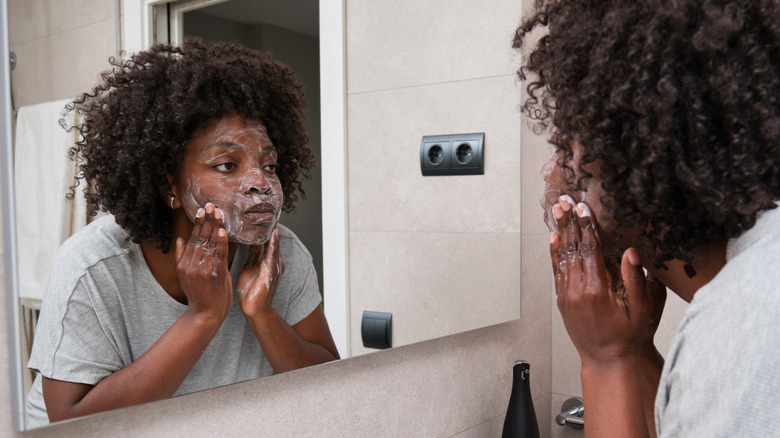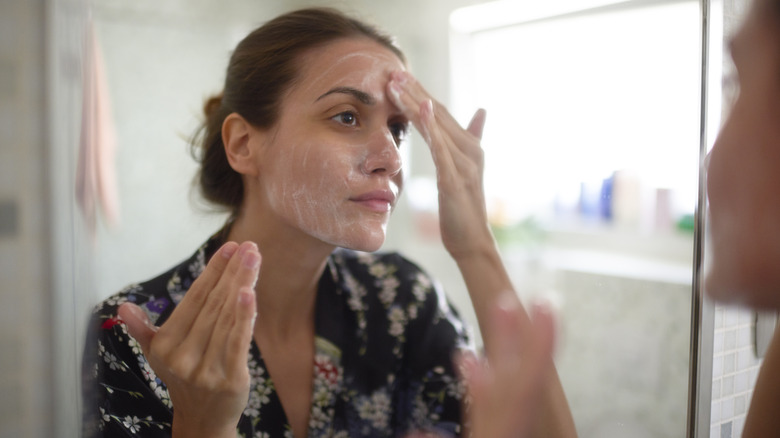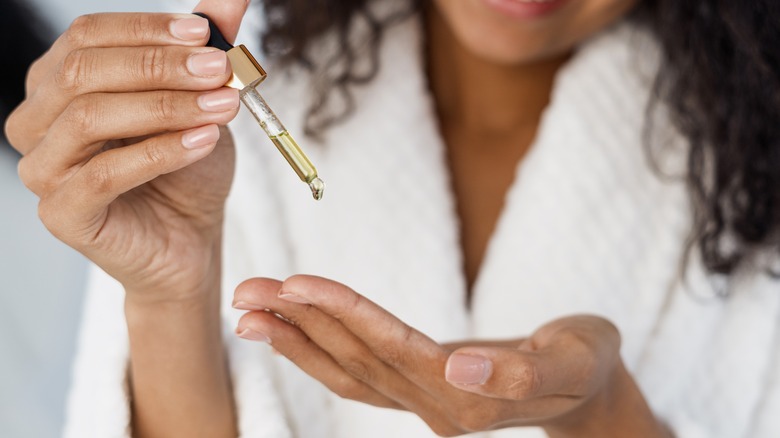Here's Exactly How & When To Use Salicylic Acid In Your Skincare Routine
If you're someone who's really into skincare, you've probably heard of salicylic acid. In recent years, dermatologists have called it one of the best ingredients you can find in an over-the-counter exfoliant or cleanser. But as much as this skincare staple is so great, the question remains: what exactly is salicylic acid? It does, after all, have a pretty intense name that might steer people away from it.
"Salicylic acid is a beta hydroxy acid," cosmetic chemist Randy Schueller tells Allure. "[This] means the hydroxy part of the molecule is separated from the acid part by two carbon atoms, as opposed to an alpha hydroxy acid where they're separated by one carbon atom. This structure is important because it makes salicylic acid more oil-soluble so it can penetrate into the pores of the skin."
In other words, unlike facial washes without salicylic acid, those that contain it really get deep into your pores to remove all the gunk that has piled up over weeks and months and, in some cases, years. This, combined with the fact that it can regulate oil production makes it great option for people with acne-prone skin. On top of that, salicylic acid also acts as an exfoliant that helps ditch that top layer of dead skin cells, creating a more even tone, as well as a healthier and brighter looking complexion. But despite the extraordinary benefits one shouldn't fall down a salicylic rabbit hole and not return, because too much a good thing can end up being a bad thing.
When to use it
Salicylic acid wipes or gels can be used as both a one-off spot treatment for active whiteheads and blackheads as well as part of your weekly acne prevention regimen. Since it is a chemical exfoliant, you'll want to be careful about using it with other actives in your routine to avoid triggering inflammation. For instance, if you're already using benzoyl peroxide, another common acne-fighting ingredient in your routine, consider using your salicylic acid treatment on alternate days. Meanwhile, Mind Body Green points out if you're using a retinol, be sure to use it at different time than your salicylic acid.
No matter the form in which the salicylic acid comes, you want to ease your way into it. This is especially true if you have rosacea or sensitive skin. Until you know how your skin is going to react, it's best to start your product once or twice a week, as board-certified dermatologist Hadley King, M.D. tells Good Housekeeping. If you find that your skin is struggling to get used to it and you can't get any possible drying effects under control, you'll want to call your dermatologist. Keep in mind that salicylic acid doesn't mesh well with some ingredients — like retinol and vitamin C, per Re'equil — so your doctor may suggest trying something else.
Start with a lower percentage
Salicylic acid typically comes available in a range of concentrations, from 0.2 up to 10%; though most over-the-counter products stop at 5%. What works best for you will ultimately depend on your skin type and specific skin issues.
If you simply want to control oily skin, you can probably manage your issues with a face wash containing 1% or less salicylic acid. However, if you're looking to treat acne, it's fine to go for something higher. Dermatologist Alok Vij, MD tells Cleveland Clinic that 2% salicylic face washes can be safely used once a day continuously as part of an acne control routine. As your skin gets used to salicylic acid, you can consider increasing the concentration, just as long you don't experience any irritation or excessive drying.
Depending on how seveSre your acne, you may consider opting for a spot treatment salicylic acid gel or cream with a higher percentage. This can be beneficial for those who have specific breakouts they want to treat. "I like salicylic acid spot treatments, serums and liquids meant to stay on the skin, versus a cleanser that is on the skin briefly and then is washed off," board-certified dermatologist Corey L. Hartman, M.D. tells Good Housekeeping. "[Serum] usually has smaller molecules of an active ingredient, which will penetrate deeper into the skin." However, some experts recommend you still limit it to a 5% concentration to prevent excess drying. As dermatologist Dr Hu tells InStyle, 2% is probably plenty good to manage acne. Apply the serum to areas that need treatment. Do not apply all over your skin.
Pay attention to overuse
Regardless of whether you're using other actives, if you're using salicylic acid as a chemical exfoliant or OTC peel, limit use to a few times a week. The U.S. National Library of Medicine warns against applying any form of salicylic acid on any broken skin or irritated areas, as this could trigger more irritation.
Do not apply salicylic acid to large areas of the body, either. If you notice after several weeks of using salicylic acid that your skin getting a bit too dry, then rollback on your usage. As dermatologist Adarsh Vijay Mudgil, MD tells Byrdie. "If [your skin is] getting irritated, you'll need to take a day or two off and perhaps be a bit more vigilant with moisturizing... Incorporating salicylic acid isn't a 'one size fits all' situation. It's best to work with your dermatologist to optimize your regimen."



